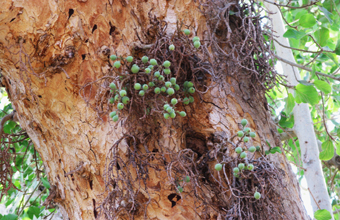

Young sycamore figs growing
from the trunk of the tree."
The sycamore fig, Ficus sycamorus, is identified with the Hebrew siqmah. Though a much taller and larger tree than the fig (Ficus carica) its fruit is inferior in quality and sweetness, and served as the food of the poor in ancient Israel. The fruit was also believed to be effective as a laxative and vermifuge.
The ancient farmers discovered that a better eating fruit could be gotten if it was first "dressed," a process in which an incision is made near the stem of the fruit a few days before it ripens. It is probably this lowly menial job to which Amos meant when he said that he "was neither a prophet nor a prophet's son, but I was a shepherd, and I also took care [Hebrew: balas] of sycamore-fig trees" (Amos 7:14). The Hebrew verb balas is found only here in the Old Testament, and so we cannot speak with absolute certainty of this association. If this association is correct, then it was unlikely that Amos could have been a very rich person. Tekoa, where he lived (Amos 1:1) was too close to the edge of the desert for sycamore fig trees to be plentiful, which suggests that he probably had to leave his home during the summer as a seasonal worker in the Shephelah.
In the OT more is said of the Shephelah being plentiful of the tree than any other fact about it; so plentiful that its use in a figure of speech is mentioned in half of the six times that the tree is referenced in the OT (1 Kings 10:27; 2 Chron 1:15; 9:27):
The king made silver as common in Jerusalem as stones, and cedar as plentiful as sycamore-fig trees in the Shephelah.
It may seem strange from what has been said about the fruit that David should place an officer, Baal-Hanan the Gederite, in charge of the olive and sycamore-fig in the Shephelah (1 Chron 27:28). But the major economic importance of the sycamore fig did not lay with its fruit but with its timber; a fact not mentioned in the Bible. In a land with few trees that could provide construction-grade timber the sycamore fig tree makes a highly prized item. Its wood is light and porous, but with considerable strength. Additionally, its ability to regenerate itself is well-known. This quality was managed into producing more wood than it naturally would. When a mature sycamore fig tree is cut down, numerous new limbs would grow from the same spot and be ready for harvesting in about six years. While usually used for roof-beams, it was also found in use in mummy coffins, furniture, boxes and doors in ancient Egypt.
The sycamore fig is mentioned only once in the New Testament, the one that Zacchaeus climbed in order to catch a glimpse of Jesus (Lk 19:1-6).

Sycamore fig tree in Jericho
Bibliograhpy:
Anchor Bible Dictionary, 2.808; N. Hareuveni, Tree and Shrub in Our Biblical Heritage (Lod, Israel: Neot Kedumim, 1984) 87-89; A. Kempinski and R. Reich, The Architecture of Ancient Israel (Jerusalem: The Israel Exploration Society, 1992) 7.

©ALBERITH